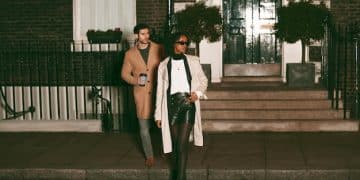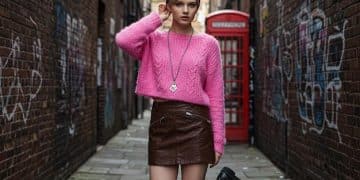Social Media’s Impact on Fashion: Staying Ahead of Trends
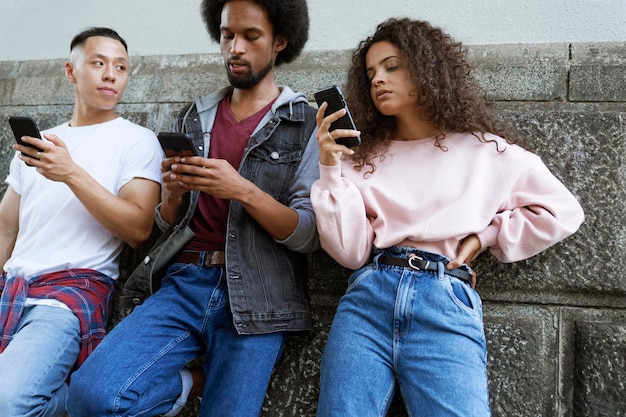
Anúncios
Social media has profoundly reshaped fashion, democratizing trend creation and accelerating their lifecycle, demanding a proactive, informed approach from consumers and industry professionals to stay relevant in this rapidly evolving landscape.
In today’s interconnected world, understanding the impact of social media on fashion trends: staying ahead of the curve is not merely an advantage, but a necessity. Social media platforms have fundamentally redefined how trends emerge, spread, and evolve, transforming the fashion industry from a hierarchical system into a dynamic, user-driven ecosystem.
Anúncios
The Digital Revolution of Fashion Forecasting
The traditional fashion calendar, once dictating trends with a rigid seasonal structure, has been irrevocably disrupted by the instantaneous nature of social media. Where designers and editors once held exclusive sway, now an army of influencers, content creators, and everyday users are shaping the sartorial narrative. This shift has necessitated a complete rethinking of how trends are identified, disseminated, and ultimately adopted by the masses. The speed at which micro-trends can emerge and gain traction is unprecedented, making traditional forecasting methods feel sluggish.
Fashion houses and brands are no longer solely relying on runway shows to gauge public interest. Instead, they are meticulously tracking engagement metrics, viral challenges, and user-generated content to identify nascent trends. This data-driven approach allows for more agile responses to consumer preferences, significantly reducing the lag time between a concept’s inception and its market availability. The democratization of trendsetting means that anyone with a strong online presence can potentially ignite the next big fashion phenomenon, blurring the lines between creator and consumer.
From Runway to Realway: The Influence of Street Style and Micro-Trends
Social media has elevated street style photography from a niche pursuit to a powerful trend indicator. Images shared by bloggers, photographers, and even ordinary commuters showcase how real people interpret and adapt high fashion for everyday wear, often sparking trends that resonate more broadly than runway concepts. This authenticity offers a valuable counterpoint to the curated world of editorials.
Anúncios
- Street style blogs and Instagram accounts serve as instant trend reports.
- Celebrities and influencers showcasing daily outfits amplify accessibility.
- Real-time public feedback validates or dismisses emerging looks.
Beyond broad trends, social media is a fertile ground for micro-trends: highly specific, often short-lived fashion phenomena that gain immense popularity within a particular online community before potentially breaking into the mainstream. These can range from a particular color palette to a unique accessory or styling technique. Understanding these fleeting moments requires constant vigilance and an acute awareness of online subcultures.
The instantaneous feedback loop provided by comments, likes, and shares allows for rapid iteration and adaptation of styles. Brands can test concepts, solicit opinions, and pivot quickly based on consumer reactions. This dynamic interaction fosters a sense of co-creation between brands and their audience, building stronger brand loyalty and ensuring products are aligned with current desires.
In essence, the digital revolution has transformed fashion forecasting into a dynamic, multi-faceted discipline that marries traditional intuition with cutting-edge data analysis. Staying ahead of the curve now means having an ear to the ground, but also an eye on the analytics, understanding that the next big thing could emerge from anywhere, at any time.
The Rise of Influencer Culture and Its Fashion Footprint
The advent of influencer culture has fundamentally reshaped fashion consumption, shifting trust from traditional media outlets to individual personalities. These digital tastemakers, whether macro-influencers with millions of followers or micro-influencers with highly engaged niche audiences, possess an undeniable power to sway purchasing decisions and accelerate trend adoption. Their authenticity and relatability often resonate more deeply with consumers than polished advertising campaigns, leading to significant brand impact.
Influencers leverage their personal style and curated content to showcase products, often integrating them seamlessly into their daily lives. This creates a sense of aspirational yet attainable fashion. From “haul” videos to “get ready with me” routines, the content they produce offers direct, often unfiltered, endorsements that traditional marketing struggles to replicate. Brands now dedicate substantial budgets to influencer collaborations, recognizing the unparalleled reach and engagement they can achieve.
Building Trust and Authenticity in a Curated World
The success of an influencer hinges on their perceived authenticity. Followers trust their recommendations because they feel a personal connection to them. This trust is built through consistent content, transparent communication, and a genuine passion for fashion. When influencers disclose sponsored content, it further solidifies this trust, demonstrating integrity to their audience. The most effective collaborations feel organic, rather than overtly commercial, allowing the product to speak for itself through the influencer’s unique lens.
- Influencers offer a relatable alternative to traditional celebrity endorsements.
- Their content often feels like a friend’s recommendation, fostering trust.
- Transparency regarding brand partnerships maintains credibility.
Authenticity is also reflected in the diversity of influencer aesthetics. Unlike the once-homogenized world of fashion magazines, social media allows for a multitude of styles, body types, and cultural backgrounds to thrive. This inclusivity ensures that a wider range of fashion trends can emerge and find a receptive audience, catering to varied tastes and preferences. The fragmentation of online communities means that niche styles can find their champions, leading to a broader and more representative fashion landscape.
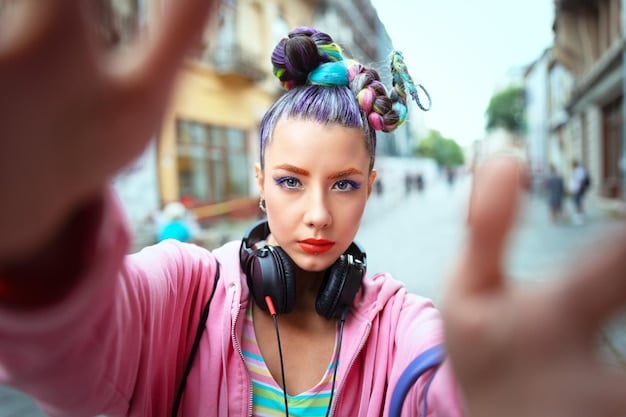
However, the rise of influencer culture also presents challenges. The sheer volume of content can lead to trend fatigue, and the ephemeral nature of online fame means that an influencer’s impact can be short-lived. Brands must carefully vet their partners, ensuring alignment not only in aesthetics but also in values and audience demographics. The most successful influencer strategies involve long-term partnerships that foster genuine advocacy, rather than one-off transactional posts.
Ultimately, influencer culture has cemented its position as a dominant force in shaping fashion trends. By understanding the nuances of authenticity, engagement, and audience connection, both brands and aspiring fashion enthusiasts can leverage this powerful medium to stay at the forefront of sartorial innovation.
From Niche to Mainstream: The Viral Power of Social Media
Social media platforms possess an unparalleled ability to catapult niche styles or previously obscure designers into the mainstream almost overnight. A single viral post, a trending hashtag, or a widely shared challenge can transform a local phenomenon into a global sensation, bypassing traditional fashion gatekeepers entirely. This speed and reach mean that what was once considered avant-garde or subcultural can quickly become a mass-market desideratum, demonstrating the fluid boundaries of contemporary fashion.
This viral power is driven by several factors: the ease of sharing content, the algorithmic amplification of popular posts, and the inherent human desire to participate in trending conversations. When a particular item or aesthetic gains traction, users are quick to replicate it, sparking a chain reaction of content creation. This organic spread is far more potent than any paid advertising, as it comes across as authentic endorsement from peers.
Understanding the Mechanics of Virality
Virality in fashion isn’t random; it often stems from a combination of novelty, relatability, and visual appeal. An unusual design, a clever styling hack, or an aesthetically pleasing outfit can capture collective attention. Platforms like TikTok, with their emphasis on short-form video and sound, are particularly effective at generating viral fashion moments, often spawning dance challenges or creative transitions centered around clothing. The “dupe” culture, where users showcase affordable alternatives to high-end items, is another significant viral phenomenon, democratizing access to popular looks.
- Hashtags act as powerful aggregation tools for viral trends.
- Algorithmic boosts push engaging content to wider audiences.
- User-generated content creates a self-sustaining cycle of popularity.
The speed with which trends go viral also shortens their lifespan. What’s “in” today might be “out” tomorrow, leading to a phenomenon known as “micro-trend fatigue.” Consumers and brands alike must adapt to this accelerated cycle, making quick decisions about adoption or rejection. For brands, this means rapidly adjusting production and marketing strategies to capitalize on fleeting opportunities, while for consumers, it means a constant refresh of wardrobes or a more mindful approach to fast fashion.
Moreover, the journey from niche to mainstream through social media is not always linear. Sometimes, a viral trend might remain within a specific subcommunity, influencing only a segment of the market. Other times, it might break through and become a global phenomenon, as seen with the rise of Y2K aesthetics or “cottagecore.” Brands savvy enough to identify these nascent viral opportunities can position themselves as trendsetters, gaining significant market share and cultural relevance.
Ultimately, the viral power of social media has made the fashion landscape more dynamic, unpredictable, and exciting. It challenges traditional notions of influence and democratizes trend dissemination, requiring constant vigilance and adaptability from everyone involved in the industry.
Consumer Empowerment and Personal Style Evolution
Social media has profoundly empowered consumers, transforming them from passive recipients of fashion dictums into active participants and even creators of trends. This shift has democratized style, allowing individuals to explore, experiment with, and express their personal aesthetic without the constraints of traditional gatekeepers or geographical limitations. The ability to instantly share and consume diverse fashion content has fostered an environment where individual expression is celebrated and encouraged, leading to a richer and more varied global style narrative.
This empowerment is evident in the prevalence of “outfit of the day” (OOTD) posts, personal style blogs, and body-positive movements that champion diverse representations of beauty and fashion. Consumers no longer feel compelled to conform to a single, prescribed ideal; instead, they are inspired by a multitude of online personalities and communities that resonate with their individual tastes and values. This has led to a natural evolution of personal style, moving away from rigid trends towards more fluid and authentic self-expression.
Breaking The Rules: Experimentation and Self-Expression
The low barrier to entry for content creation on social media means anyone can become a style curator. This freedom has encouraged widespread experimentation with clothing, accessories, and styling techniques. Users are constantly pushing boundaries, mixing high and low fashion, repurposing vintage pieces, and creating unique looks that reflect their individuality. This playful approach to dressing contrasts sharply with past eras where fashion was often about strict adherence to designer directions.
- Social media offers a democratic platform for style exploration.
- The emphasis on individuality fosters unique fashion interpretations.
- Global inspiration broadens perspectives on what is considered “stylish.”
Furthermore, social media serves as a powerful feedback mechanism for personal style. Likes, comments, and direct messages provide immediate validation and constructive criticism, allowing individuals to refine their aesthetic based on audience reception. This interactive element turns personal styling into an ongoing conversation, encouraging continuous evolution and refinement. It also provides a sense of community for those with shared fashion interests, fostering collective growth and inspiration.
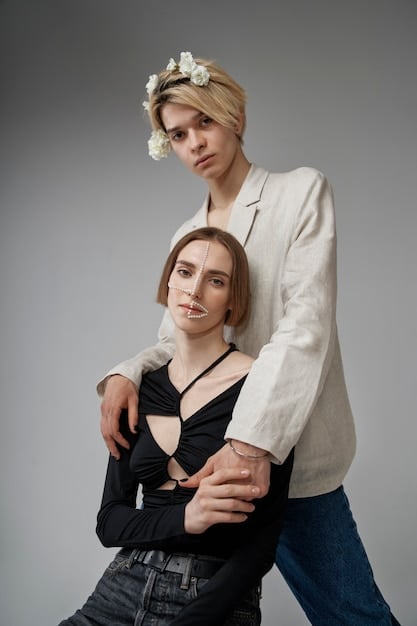
However, this constant exposure to idealized images can also lead to feelings of inadequacy or the pressure to constantly consume. The fast pace of trends, propelled by consumer demand for novelty, can contribute to overconsumption and unsustainable fashion practices. Balancing the desire for self-expression with conscious consumption remains a critical challenge in this digitally driven fashion landscape.
Ultimately, social media has put the power of fashion firmly into the hands of the consumer. It has fostered an unprecedented era of personal style evolution, where individuality, authenticity, and community-driven inspiration are the cornerstones of contemporary dressing. Staying ahead means embracing this empowerment and using it to cultivate a style that is both current and genuinely reflective of oneself.
Sustainability and Ethical Fashion in the Social Media Age
The amplified voice of social media has become a critical catalyst for the sustainability and ethical fashion movement. Where once these concerns were confined to niche communities, platforms like Instagram and TikTok have propelled them into mainstream consciousness, holding brands accountable and empowering consumers to make more informed choices. The rapid dissemination of information—and misinformation—means that transparency and authenticity are paramount for brands aiming to resonate with eco-conscious audiences.
From exposés on fast fashion’s environmental impact to educational content on sustainable materials, social media serves as a powerful megaphone for activists, educators, and ethical brands. Hashtags like #slowfashion, #sustainablefashion, and #ethicalconsumerism rally communities and pressure the industry to adopt more responsible practices. This collective digital activism is directly influencing consumer behavior and, consequently, forcing a re-evaluation of production processes within the fashion supply chain.
Transparency and Accountability Through Digital Platforms
Social media provides an unprecedented level of transparency, enabling consumers to scrutinize a brand’s claims and practices. Influencers and watchdog accounts often conduct deep dives into company policies, supply chains, and labor practices, sharing their findings with a broad audience. This public accountability pushes brands towards greater honesty, compelling them to disclose information about their environmental footprint, fair labor wages, and ethical sourcing. Those failing to meet these expectations risk significant reputational damage and consumer backlash.
- Platforms enable real-time scrutiny of brand practices and claims.
- Educational content on sustainable materials empowers conscious consumption.
- Hashtag movements amplify ethical concerns globally.
Moreover, social media platforms have facilitated the growth of second-hand and vintage fashion markets. Apps and communities dedicated to resale, swapping, and renting clothes reduce the demand for new production, promoting a circular economy. This shift reflects a growing consumer desire to extend the life cycle of garments and reduce waste, often driven by the aesthetic and financial appeal of unique, pre-loved items as highlighted by influencers. The “buy less, choose well” mantra has found its digital champions, inspiring many to adopt more minimalist and curated wardrobes.
Despite the positive impact, challenges remain. Greenwashing, where brands misleadingly portray themselves as eco-friendly, can confuse consumers. The speed of social media can also lead to superficial understanding of complex issues, where quick fixes are favored over systemic change. For ethical fashion to truly flourish, a nuanced understanding and continuous dialogue are essential, powered by reliable information shared by credible sources.
Ultimately, social media has made sustainability and ethical considerations integral to the modern fashion narrative. It empowers consumers to demand more, provides a platform for education and advocacy, and forces the industry to confront its environmental and social responsibilities. Staying ahead in this evolving landscape means embracing transparency and actively participating in the movement towards a more conscious fashion future.
Navigating the Future: Trends That Define Tomorrow’s Fashion
As social media continues to evolve, so too will its influence on fashion. Predicting tomorrow’s trends involves not just observing current viral phenomena but understanding the underlying technological and societal shifts shaping our digital interactions. The future of fashion, deeply intertwined with social media, promises even greater personalization, immersive experiences, and a heightened emphasis on digital realms, demanding agility from both creators and consumers.
One undeniable future trend is the continued blurring of lines between physical and digital fashion. The metaverse, NFTs, and virtual try-on technologies are not merely fleeting fads but represent a fundamental shift in how we conceive, experience, and even “wear” clothes. Digital fashion offers limitless creative possibilities, sustainability benefits, and new avenues for self-expression, particularly appealing to younger generations who spend significant time in virtual spaces.
The Metaverse, AI, and Hyper-Personalization
The metaverse is set to become a significant arena for fashion, with brands creating digital collections, virtual storefronts, and customizable avatars. NFTs (Non-Fungible Tokens) offer a way to own unique digital garments, creating new forms of scarcity and collectibility. AI, meanwhile, will revolutionize personalization, predicting individual style preferences, suggesting tailored outfits, and even designing bespoke pieces based on user data. This hyper-personalization will move beyond simple recommendations to truly unique, AI-generated fashion concepts.
- Digital fashion in the metaverse offers new creative and commercial frontiers.
- AI will drive hyper-personalized fashion recommendations and bespoke designs.
- Augmented Reality (AR) will enhance virtual try-on experiences.
Another defining trend is the rise of augmented reality (AR) in e-commerce. AR filters on platforms like Instagram and Snapchat already allow users to virtually “try on” clothing and accessories. This technology will become more sophisticated, offering realistic simulations that enhance online shopping experiences and reduce returns. Imagine being able to see how a garment drapes and moves on your body, all from the comfort of your home, before making a purchase.
The direct-to-consumer (DTC) model, heavily facilitated by social media, will continue to thrive, allowing smaller, agile brands to compete with established players. These brands excel at building strong online communities and responding rapidly to consumer feedback, fostering a deeper sense of connection and loyalty. Influencer marketing will also mature, shifting towards more authentic, long-term partnerships and a greater focus on measurable ROI.
Ultimately, staying ahead in tomorrow’s fashion landscape means embracing innovation, understanding the interplay between technology and human connection, and recognizing that fashion is becoming an increasingly immersive, personalized, and digitally informed experience. The future of fashion is undeniably social, interconnected, and constantly on the move.
| Key Aspect | Brief Impact Description |
|---|---|
| 📈 Trend Acceleration | Social media dramatically speeds up trend lifecycles, from emergence to obsolescence. |
| 🎤 Influencer Power | Influencers drive adoption and shape perception, influencing millions through authentic content. |
| 🛍️ Consumer Empowerment | Consumers actively participate in trend creation and express diverse personal styles. |
| 🌍 Global Reach | Niche styles can instantly go global, fostering diverse and inclusive trends. |
Frequently Asked Questions About Social Media and Fashion
Social media has significantly accelerated the fashion calendar by enabling instantaneous trend dissemination. Unlike seasonal runway shows, trends can emerge and gain traction online in real-time, often driven by influencers and viral content. This requires brands to be more agile and responsive, adopting a “see now, buy now” mentality rather than adhering to rigid, pre-planned collections.
Micro-influencers, with their smaller yet highly engaged and niche audiences, often play a crucial role in validating and spreading micro-trends. Their authenticity and relatable content typically foster deeper trust with followers, leading to higher conversion rates and genuine adoption of styles they promote. They can tap into specific communities that larger influencers might overlook, making their impact significant within certain segments.
Social media fuels fast fashion by accelerating trend cycles and creating constant demand for newness. The rapid viral spread of styles encourages quick consumption and disposal of clothing, exacerbating environmental issues like textile waste and carbon emissions. However, social media also amplifies awareness about these problems, promoting sustainable alternatives and holding brands accountable for their practices.
Absolutely. Social media has democratized trendsetting, allowing individual users with unique style or compelling content to spark viral moments. A creative styling idea, a rediscovered vintage piece, or a compelling personal narrative can garner widespread attention and inspire others, demonstrating that influence is no longer exclusive to industry insiders or celebrities, but is accessible to anyone with a strong digital presence.
The metaverse and AI are poised for significant impact. The metaverse will offer new spaces for digital fashion, virtual try-ons, and immersive brand experiences. AI will drive hyper-personalization, from predicting style preferences to generating unique designs, revolutionizing how consumers discover and interact with fashion. Augmented reality (AR) filters will also become more sophisticated, enhancing virtual try-on capabilities and bridging the gap between digital and physical clothing.
Conclusion
The profound integration of social media into the fabric of fashion has irrevocably altered its landscape, transforming it into a dynamic, interactive, and often unpredictable realm. We’ve moved beyond a world where trends were dictated from above, entering an era where influence is crowdsourced, authenticity is prized, and speed is paramount. Staying ahead of the curve now demands a nuanced understanding of digital ecosystems, from algorithmic shifts to the subtle nuances of influencer authenticity and the potent force of viral content. As fashion continues its rapid evolution, fueled by emergent technologies like AI and the metaverse, adaptability and a keen ear to the digital ground will be the ultimate determinants of success for both brands and individuals navigating this exciting, ever-changing sartorial journey.



